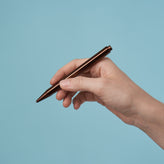István spent 30 days with the grand voyageur and here are his thoughts
Get ready for an inspiring journey from István, a distinguished Hungarian writer and blogger. He's taken our paper republic journal beyond the ordinary, using it as a diary, notebook, and more. In his engaging essay, István shares his one-month experience with our grand voyageur, offering a glimpse into a professional writer's world. Discover through his eyes why our journal is much more than just a notebook:
30 days with the grand voyageur as a writer
I've always wanted to be someone who reaches for their notebook instead of their phone to take notes; who rejects the speed of technology in exchange for the creative potential of analog tools; who doesn't mind if something takes extra effort because they know it means the importance of the exercise.
It's true that analog tools can seem counterproductive - no instant sync, no updates or backups, and even slower to use - but slowing down can give us much more: peace of mind, reflection, creative fulfillment, deeper understanding. We already know that in the creative and intellectual life, speed is rarely an advantage.
Take the technique of speed reading, for example. A technique that every bookworm wants to master, but is unaware of the consequences. But we now know, thanks to a lot of research, that people can actually read very fast, but at a price: the faster we read, the less we understand. For me, the same principle goes for writing and thinking.
Besides the desire to slow down, I have always been fascinated by the note-taking habits of great thinkers. The observations of Leonardo da Vinci, who expressed his curiosity in his notebooks; the sudden ideas of Ludwig van Beethoven, whose biographer Wilhelm Von Lenz wrote in 1855:
When Beethoven was enjoying a beer, he might suddenly pull out his notebook and write something in it. ‘Something just occurred to me,’ he would say, sticking it back into his pocket. The ideas that he tossed off separately, with only a few lines and points and without barlines, are hieroglyphics that no one can decipher. Thus in these tiny notebooks he concealed a treasure of ideas.
Perhaps the Stoic philosopher Seneca was the first to mention the need to collect your ideas in one place—say, a notebook—back in the first century:
We should hunt out the helpful pieces of teaching and the spirited and noble-minded sayings which are capable of immediate practical application—not far far-fetched or archaic expressions or extravagant metaphors and figures of speech—and learn them so well that words become works.
Among many others, they inspired me to choose a simpler alternative in the age of efficiency: notebooks and journals.
During my years as a note-taker, I developed a pattern: every time I start a new notebook, I try something new. This was difficult to do before, as I usually kept two or three notebooks at the same time: a handwritten diary, a commonplace book, daily to-do lists, a typewritten diary, typewritten book summaries. All stored in separate notebooks and folders that I can't always keep with me. This also meant that trying new things became impossible with so many notebooks.


Over the next 30 days, as you might have guessed, there were occasions when I forgot to take the notebook with me on a long walk, saying I wouldn't need it anyway. Almost as a rule, I would always think of something that I couldn't write down, and by the time I got home to write it in my notebook, I had forgotten it.
I particularly enjoyed cutting my own notebook refills to size and stapling them together so I could write on them with my typewriter. After a good few pages were filled and put into the grand voyageur, I felt like I was creating a book. And as a writer and author, it is a pretty damn good feeling.
Luckily for me, the team of aper republic was so kind to send me a notebook set specifically for writers. This solved my current problem, as their notebooks have interchangeable refills. This way I am able to carry three “notebooks” bound together at a time, which I can simply replace when they fill up. As soon as the package arrived, I decided what changes I would make.
And what is my experience after 30 days? I think a conversation with a friend I met recently in a café illustrates it well. He spotted my new notebook straight away, because I was writing in it when he arrived.
‘I like your notebook,’ he said.
‘Thanks! I like it too. I'm actually testing it now. It's from an Austrian company.’
‘How is that?’
‘You know how much I write. I usually keep several notebooks with me at the same time, and this is one of those notebooks that has replaceable refills. Look’ I take out a notebook refill so he can see how it works, and then I put it back.
‘Now that is something. How is it so far?’ He asks.
‘I like to say that it's not the tool that makes the writer or the artist. You can always do something with what you already have, you don't need any premium tools, you just have to be creative. Although, in my case, this notebook provided one thing certainly: comfort. Not having to carry three notebooks with me at all times now seems a privilege.’
‘Convenience.’ He went on staring at this little notebook. ‘That's what we always pay for.’
Beyond the comfort, I have thoroughly enjoyed the development of my new workflow. Since this notebook of mine functions simultaneously as a diary, a commonplace book, and a place for research notes, and book notes, every time I sat down to write, the first thing I did was to flip through the relevant pages. I always found inspiration, even when I felt I was approaching a creative block. And all this was only 30 days. I can't imagine what I will experience later if I maintain this routine for three, six or twelve months. So I am determined to keep doing it to find out.
- G. István Göblyös


![[pocket] / reef / plain | [pocket] / récif / blanches | [pocket] / Ozean / blanko | [pocket] / Barriera corallina / pagine bianche](http://www.paper-republic.com/cdn/shop/files/06_PR_DYBDHAL_MAY_Square_014_53e26280-f35c-49f6-87ef-4549c61bc5fe.jpg?v=1715667555&width=164)
